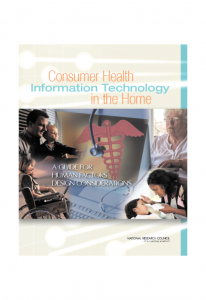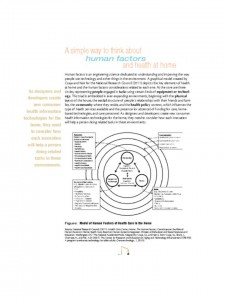 The Internet, broadband, mobile health platforms, and consumers’ demand for more convenient health care services are fueling the development and adoption of health technologies in peoples’ homes. However, designing products that people will delight in using is based on incorporating human factors in design. Human factors are part of engineering science and account for the people using the device, the equipment being used, and the tasks the people are undertaking. The model illustrates these three interactive factors, along with the outer rings of environments: health policy, community, social, and physical.
The Internet, broadband, mobile health platforms, and consumers’ demand for more convenient health care services are fueling the development and adoption of health technologies in peoples’ homes. However, designing products that people will delight in using is based on incorporating human factors in design. Human factors are part of engineering science and account for the people using the device, the equipment being used, and the tasks the people are undertaking. The model illustrates these three interactive factors, along with the outer rings of environments: health policy, community, social, and physical.
Getting these aspects right in the design of health technologies meant for use by people at home is critical for consumer adoption and sustained use. The implications of this are detailed in the report, Consumer Health Information Technology in the Home, published by the National Academies of Science National Research Council’s Committee on the Role of Human Factors in Home Health Care. This report is based on a workshop held by the Committee in 2010, funded by the Agency for Healthcare Research and Quality (AHRQ).
First, consider the person: this includes people who are well, people managing chronic conditions, children, people with disabilities, and  older people who are at risk for managing multiple conditions at the same time. In addition, some technologies will be used by both formal and informal caregivers. Each of these person-players has different needs, abilities, and levels of engagement. Devices need to be designed with these aspects in the core design process.
older people who are at risk for managing multiple conditions at the same time. In addition, some technologies will be used by both formal and informal caregivers. Each of these person-players has different needs, abilities, and levels of engagement. Devices need to be designed with these aspects in the core design process.
Second, consider the equipment and technologies used in the home. The Committee identifies a score of usability issues, including size, portability, interfaces, software functionality, and hardware platforms. Furthermore, designers need to determine the maintenance requirements for the equipment, how much instruction will be required, and data security.
Third, what tasks will the person and equipment be addressing? These range from self-monitoring, self-care, disease management, and communication — often all four of these tasks could be involved.
Finally, every one’s home is an “N” of “1.” The report points out that in the U.S., 79 mm homes are single family detached houses, 28 million are multifamily units, 5 million are duplexes, and 9 million about mobile homes.
Culture is a key component that is often overlooked in the development of home-based health technologies. “Culture,” broadly defined, deals with peoples’ behaviors and beliefs that are shaped by their ethnic, racial, national and religious identities. These influence peoples’ health beliefs, along with language, mental models of illness, and trust in the health system and providers.
Health Populi’s Hot Points: In the dozens of business plans I’ve reviewed for health start-ups in 2011, very few have considered and spoken to the issue of human-centered design. This is particularly crucial for products and services meant for peoples’ self-care — that is “DIY health” in the home. The fact that people have downloaded countless mobile health apps, but few sustain use of them, is surely associated with the lack of designing for engagement, delight, and people-centeredness.
This report is required reading for developers and designers of health tech’s targeting people at home, along with the vendors who market these products. If you build it, we know “they” won’t come — without attending to designing for real people, with real lives, in real homes.




 Interviewed live on BNN Bloomberg (Canada) on the market for GLP-1 drugs for weight loss and their impact on both the health care system and consumer goods and services -- notably, food, nutrition, retail health, gyms, and other sectors.
Interviewed live on BNN Bloomberg (Canada) on the market for GLP-1 drugs for weight loss and their impact on both the health care system and consumer goods and services -- notably, food, nutrition, retail health, gyms, and other sectors. Thank you, Feedspot, for
Thank you, Feedspot, for  As you may know, I have been splitting work- and living-time between the U.S. and the E.U., most recently living in and working from Brussels. In the month of September 2024, I'll be splitting time between London and other parts of the U.K., and Italy where I'll be working with clients on consumer health, self-care and home care focused on food-as-medicine, digital health, business and scenario planning for the future...
As you may know, I have been splitting work- and living-time between the U.S. and the E.U., most recently living in and working from Brussels. In the month of September 2024, I'll be splitting time between London and other parts of the U.K., and Italy where I'll be working with clients on consumer health, self-care and home care focused on food-as-medicine, digital health, business and scenario planning for the future...